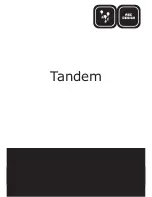
5-270
L30 LINE CURRENT DIFFERENTIAL SYSTEM – INSTRUCTION MANUAL
CONTROL ELEMENTS
CHAPTER 5: SETTINGS
5
The steady-state frequency of a power system is a certain indicator of the existing balance between the generated power
and the load. Whenever this balance is disrupted through the loss of an important generating unit or the isolation of part
of the system from the rest of the system, the effect is a reduction in frequency. If the control systems of the system
generators do not respond fast enough, the system can collapse. A reliable method to quickly restore the balance between
load and generation is to automatically disconnect selected loads, based on the actual system frequency. This technique,
called “load-shedding,” maintains system integrity and minimize widespread outages. After the frequency returns to
normal, the load can be restored automatically or manually.
UNDERFREQ 1 SOURCE
— This setting is used to select the source for the signal to be measured. The element first checks for
a live phase voltage available from the selected source. If voltage is not available, the element attempts to use a phase
current. If neither voltage nor current is available, the element does not operate, as it does not measure a parameter
below the minimum voltage/current setting.
UNDERFREQ 1 MIN VOLT/AMP
— Selects the minimum per unit voltage or current level required to allow the underfrequency
element to operate. This threshold is used to prevent an incorrect operation because there is no signal to measure.
UNDERFREQ 1 PICKUP
— Selects the level at which the underfrequency element is to pickup. For example, if the system
frequency is 60 Hz and the load shedding is required at 59.5 Hz, the setting is 59.50 Hz.
Figure 5-142: Underfrequency logic
5.8.6 Frequency rate of change (ANSI 81R)
SETTINGS
CONTROL ELEMENTS
FREQUENCY RATE OF CHANGE
FREQUENCY RATE OF CHANGE 1(2)
FREQUENCY RATE
OF CHANGE 1
FREQ RATE 1
FUNCTION: Disabled
Range: Disabled, Enabled
FREQ RATE 1 SOURCE:
SRC 1
Range: SRC 1, SRC 2
FREQ RATE 1 TREND:
Increasing
Range: Increasing, Decreasing, Bi-directional
FREQ RATE 1 PICKUP:
0.50 Hz/sec
Range: 0.10 to 15.00 Hz/sec in steps of 0.01
FREQ RATE 1 OV SUPV
PICKUP: 0.700 pu
Range: 0.100 to 3.000 pu in steps of 0.001
FREQ RATE 1 OC SUPV
PICKUP: 0.200 pu
Range: 0.020 to 30.000 pu in steps of 0.001
FREQ RATE 1 MIN
FREQUENCY: 45.00 Hz
Range: 20.00 to 80.00 Hz in steps of 0.01
FREQ RATE 1 MAX
FREQUENCY: 65.00 Hz
Range: 20.00 to 80.00 Hz in steps of 0.01
FREQ RATE 1 PICKUP
DELAY: 0.000 s
Range: 0 to 65.535 s in steps of 0.001
FREQ RATE 1 RESET
DELAY: 0.000 s
Range: 0 to 65.535 s in steps of 0.001
Содержание L30
Страница 10: ...x L30 LINE CURRENT DIFFERENTIAL SYSTEM INSTRUCTION MANUAL TABLE OF CONTENTS ...
Страница 14: ...1 4 L30 LINE CURRENT DIFFERENTIAL SYSTEM INSTRUCTION MANUAL FOR FURTHER ASSISTANCE CHAPTER 1 INTRODUCTION 1 ...
Страница 126: ...3 68 L30 LINE CURRENT DIFFERENTIAL SYSTEM INSTRUCTION MANUAL CONNECT TO D400 GATEWAY CHAPTER 3 INSTALLATION 3 ...
Страница 214: ...4 88 L30 LINE CURRENT DIFFERENTIAL SYSTEM INSTRUCTION MANUAL FLEXLOGIC DESIGN USING ENGINEER CHAPTER 4 INTERFACES 4 ...
Страница 582: ...7 16 L30 LINE CURRENT DIFFERENTIAL SYSTEM INSTRUCTION MANUAL TARGETS MENU CHAPTER 7 COMMANDS AND TARGETS 7 ...
Страница 598: ...9 6 L30 LINE CURRENT DIFFERENTIAL SYSTEM INSTRUCTION MANUAL TESTING CHAPTER 9 COMMISSIONING 9 ...
Страница 622: ...10 24 L30 LINE CURRENT DIFFERENTIAL SYSTEM INSTRUCTION MANUAL FAULT LOCATOR CHAPTER 10 THEORY OF OPERATION 10 ...
Страница 670: ...A 18 L30 LINE CURRENT DIFFERENTIAL SYSTEM INSTRUCTION MANUAL FLEXANALOG ITEMS APPENDIX A FLEXANALOG OPERANDS A ...
Страница 678: ...C 6 L30 LINE CURRENT DIFFERENTIAL SYSTEM INSTRUCTION MANUAL COMMAND LINE INTERFACE APPENDIX C COMMAND LINE INTERFACE C ...
Страница 682: ...D 4 L30 LINE CURRENT DIFFERENTIAL SYSTEM INSTRUCTION MANUAL REVISION HISTORY APPENDIX D MISCELLANEOUS D ...
Страница 686: ...iv L30 LINE CURRENT DIFFERENTIAL SYSTEM INSTRUCTION MANUAL ABBREVIATIONS ...
















































